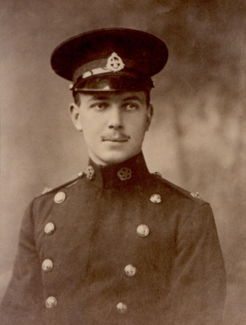Lieutenant William Malcolm Chisholm (1892-1914)
 |
| William Malcolm Chisholm, circa 1911 (Sydney Grammar School archives) |
This blog post presents items about Lieutenant William Malcolm Chisholm of Sydney, who has been officially recognised by the Australian War Memorial as the first Australian to be killed in the First World War. This occurred belatedly on 9 July 2014 when his name was finally added to the Memorial's Commemorative Roll. Lt Chisholm was not serving in Australian uniform but as a commissioned officer of the British Army's 1st Battalion, East Lancashire Regiment. He was wounded at the Battle of Le Cateau on 26 August 1914, just three days after arriving in France, and died the next day. He was 22 years of age and is buried in Ligny-en-Cambresis cemetery, where his headstone bears the inscription "Elder son of Dr. & Mrs William Chisholm of Sydney, New South Wales".
Lt Chisholm was born in Sydney in 1892, the eldest son of an eminent Macquarie Street surgeon. He grew up on Macquarie Street and attended Sydney Grammar School where he was a prefect and paraded with the 3rd Battalion Senior Cadets. He was later commissioned into the New South Wales Scottish Rifles and in 1911 was accepted for admission by Royal Military College, Sandhurst. He was gazetted into the 1st Battalion, East Lancashire Regiment, in 1913 and embarked for France in August 1914.
.png) |
| Officers of 1st Battalion, East Lancashire Regiment |
.png) |
| 1st Battalion East Lancashires in the line at Solesmes on 25 August 1914 (Lancashire Infantry Museum) |
.png) |
| Sydney Morning Herald, 27 October 1914 The Evening News (Sydney), 5 November 1914, page 5 |
AN AUSTRALIAN FALLS. SON OF DR. CHISHOLM OF SYDNEY
An Australian, Lieutenant Malcolm Chisholm, who had a brilliant future, has died from wounds received while fighting against the Germans in Belgium. He was the elder son of Dr. William Chisholm, of Macquarie Street, Sydney, and was 22 years old. Educated at the Sydney Grammar School where he achieved considerable success, it was hoped he would follow in his father's footsteps and become a doctor. But it was his ambition to be a soldier. Going to England about four years ago, he passed examinations and was granted a commission in the East Lancashire Regiment. It was during the fighting at Mons in August that Lieutenant Chisholm was wounded in the stomach. He was in the magnificent rear-guard action that Field Marshal Sir John French has fully described in his dispatch. A pencil note was received by Lieutenant Chisholm's parents from his major telling of the injury, and that it was regretted they were unable to take the wounded with them. The information was also given that Lieutenant Chisholm had been made comfortable under shelter. A couple of days later another message was received to the effect that the soldier had been seen by a nurse, and that he was being looked after by an English doctor in German territory. Then there was silence until a notification was received of his having died. The news reached Sydney yesterday. When the last mail left England Lieutenant Chisholm's brother Colin was being trained with Kitchener's Army.
.png) |
| Newcastle Morning Herald and Miner's Advocate, 6 November 1914 The Argus, 12 November 1914 |
 |
| The Argus, 12 November 1914 Queensland Figaro, 28 November 1918 |
 |
| Imperial War Memorial record |
.png) |
| Sydney Morning Herald, 15 March 1915 |
.png)
.png)
.png)



.png)

.png)
.png)

Comments
Post a Comment